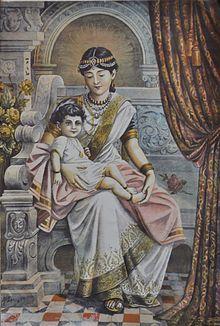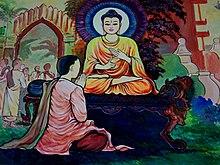Prajapati Gautami | |
|---|---|
 Prince Siddhartha with Mahaprajapati Gautami | |
| Personal | |
| Born | Pajāpatī Devdaha |
| Religion | Buddhism |
| Spouse | King Śuddhodana |
| Children | Nanda Sundari Nandaa |
| Parents |
|
| Occupation | Bhikkhuni |
| Relatives | Suppabuddha (brother) Yashodhara (daughter in law) Maya Devi (Sister) |
| Senior posting | |
| Teacher | Gautama Buddha |
Mahāpajāpatī Gotamī (Pali; Sanskrit Mahāprajāpatī Gautamī) was the step-mother and maternal aunt (mother's sister) of the Buddha. In Buddhist tradition, she was the first woman to seek ordination for women, which she did from Gautama Buddha directly, and she became the first bhikkhuni (Buddhist nun).[1][2]
Biography
Tradition says Maya and Mahāpajāpatī Gotamī were Koliyan princess and sisters of Suppabuddha. Mahāpajāpatī was both the Buddha's maternal aunt and adoptive mother,[2] raising him after her sister Maya, the Buddha's birth mother, died.[3] Mahāpajāpatī died at the age of 120.[4]
"The story of the parinirvāṇa of Mahāprajāpatī Gautamī and her five hundred bhikṣuṇī companions was popular and widely transmitted and existed in multiple versions."[5] It is recorded in the various surviving Vinaya traditions, including the Pāli Canon and Sarvastivada and Mulasarvastivada versions.[5]
An eminent Therī, Mahāpajāpatī was born at Devadaha in the family of Suppabuddha as the younger sister of Māyā.[6] Mahāpajāpatī was so called because, at her birth, augurs prophesied[7] that she would have a large following.[7] Both sisters married King Suddhodhana,[3] leader of the Śākya. When Māyā died seven days after the birth of the Bodhisatta (the "Buddha-to-be"), Pajāpati looked after the Bodhisatta and nursed him.[3] She raised the Buddha and had her own children, Siddhartha's half-brother Nanda and half-sister Nanda.
Ordination of the first woman
When King Suddhodhana, died, Mahapajapati Gotami decided to attain ordination.[3] Mahapajapati Gotami went to the Buddha and asked to be ordained into the Sangha.[2] The Buddha refused[2] and went on to Vesāli. Undaunted, Gotami cut off her hair[2] and donned yellow robes[2] and with many Sakyan ladies followed the Buddha to Vesāli on foot.[2][8] Upon arrival, she repeated her request to be ordained. Ananda, one of the principal disciples and an attendant of the Buddha, met her and offered to intercede with the Buddha on her behalf.[2]
Respectfully he questioned the Buddha, "Lord, are women capable of realising the various stages of sainthood as nuns?"
"They are, Ananda," said the Buddha.
"If that is so, Lord, then it would be good if women could be ordained as nuns," said Ananda, encouraged by the Buddha's reply.
"If, Ananda, Maha Pajapati Gotami would accept the Eight Conditions it would be regarded that she has been ordained already as a nun."[2]
Gotami agreed to accept the Eight Garudhammas and was accorded the status of the first bhikkhuni.[2] Subsequent women had to undergo full ordination to become nuns.
References
- ^ "A New Possibility". Congress-on-buddhist-women.org. Retrieved 2010-11-19.
- ^ a b c d e f g h i j The Life of the Buddha: (Part Two) The Order of Nuns
- ^ a b c d "Maha Pajapati Gotami". Archived from the original on 2015-01-28. Retrieved 2010-11-07.
- ^ Dhammadharini: Going Forth & Going Out ~ the Parinibbana of Mahapajapati Gotami - Dhammadharini Archived 2013-02-21 at Archive.today
- ^ a b Dhammadinā, The Parinirvāṇa of Mahāprajāpatī Gautamī and Her Followers in the Mūlasarvāstivāda Vinaya
- ^ Relatives and Disciples of the Buddha (archived 2011)
- ^ a b Women of the Buddhist scriptures: Mahapajapati Gotami
- ^ Bhikkhunis (archived 2011)
Bibliography
- Analayo (2011). Mahapajapati´s going forth in the Madhyama agama, Journal of Buddhist Ethics 18, 268-317
- Anālayo, Bhikkhu (2016). The Going Forth of Mahāpajāpatī Gotamī in T 60, Journal of Buddhist Ethics 23, 1-31
- Scott, Rachel M (2010). Buddhism, miraculous powers, and gender - rethinking the stories of Theravada nuns, Journal of the International Association of Buddhist Studies 33 (1-2), 489-511
- Buswell, Robert E., ed. (2004). Encyclopedia of Buddhism. Macmillan Reference USA. pp. 489–490. ISBN 0-02-865718-7.
- Walters, Jonathan S. (1994). “A Voice from the Silence: The Buddha's Mother's Story.” History of Religions 33, 350–379
- Garling, Wendy (2016). Stars at Dawn: Forgotten Stories of Women in the Buddha's Life, Shambhala Publications. ISBN 978-1-61180-265-8
